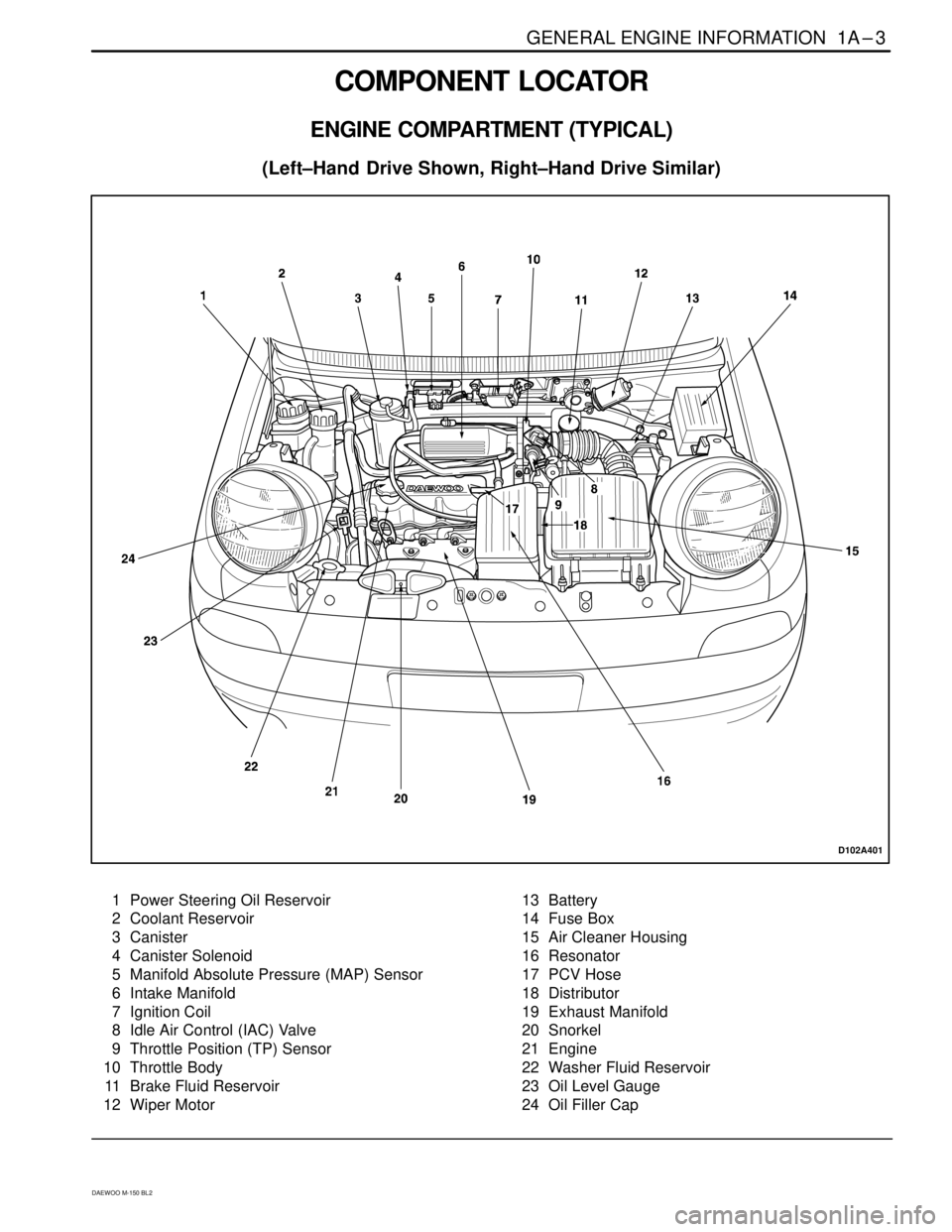coolant reservoir DAEWOO MATIZ 2003 Service Repair Manual
[x] Cancel search | Manufacturer: DAEWOO, Model Year: 2003, Model line: MATIZ, Model: DAEWOO MATIZ 2003Pages: 1184, PDF Size: 36 MB
Page 13 of 1184

GENERAL ENGINE INFORMATION 1A–3
DAEWOO M-150 BL2
COMPONENT LOCATOR
ENGINE COMPARTMENT (TYPICAL)
(Left–Hand Drive Shown, Right–Hand Drive Similar)
D102A401
1 Power Steering Oil Reservoir
2 Coolant Reservoir
3 Canister
4 Canister Solenoid
5 Manifold Absolute Pressure (MAP) Sensor
6 Intake Manifold
7 Ignition Coil
8 Idle Air Control (IAC) Valve
9 Throttle Position (TP) Sensor
10 Throttle Body
11 Brake Fluid Reservoir
12 Wiper Motor13 Battery
14 Fuse Box
15 Air Cleaner Housing
16 Resonator
17 PCV Hose
18 Distributor
19 Exhaust Manifold
20 Snorkel
21 Engine
22 Washer Fluid Reservoir
23 Oil Level Gauge
24 Oil Filler Cap
Page 14 of 1184

1A–4 GENERAL ENGINE INFORMATION
DAEWOO M-150 BL2
ENGINE COMPARTMENT (EURO III)
(Left–Hand Drive Shown, Right–Hand Drive Similar)
MAA1A010
1 Power Steering Oil Reservoir
2 Coolant Reservoir
3 Canister Purge Solenoid
4 Manifold Absolute Pressure (MAP) Sensor
5 Intake Manifold
6 Throttle Position (TP) Sensor
7 Throttle Body
8 Idle Air Control (IAC) Valve
9 Brake Fluid Reservoir
10 Wiper Motor11 Battery
12 Fuse Box
13 Air Cleaner Housing
14 Resonator
15 Electronic Ignition System Ignition Coil
16 Exhaust Manifold
17 Snorkel
18 Engine
20 Washer Fluid Reservoir
19 Oil Level Gauge
21 Oil Filler Cap
Page 40 of 1184

1D – 2 ENGINE COOLING
DAEWOO M-150 BL2
DESCRIPTION AND OPERATION
GENERAL DESCRIPTION
The cooling system maintains the engine temperature at
an efficient level during all engine operating conditions.
When the engine is cold the cooling system cools the
engine slowly or not at all. This slow cooling of the en-
gine allows the engine to warm up quickly.
The cooling system includes a radiator(a) and cooling
fan(b), a thermostat and housing(c), a coolant pump(d),
a coolant pump drive belt and coolant hose. The timing
belt drives the coolant pump.
All components must function properly in order for the
cooling system to operate. The coolant pump draws the
coolant from the radiator. The coolant then circulates
through water jackets in the engine block and the cylin-
der head, distributor case(e), throttle body(f). When the
coolant reaches the operating temperature of the ther-
mostat, the thermostat opens. The coolant then goes
back to the radiator where it cools.
This system directs some coolant through the hoses to
the heater core(g). This provides for heating and de-
frosting. The surge tank(h) is connected to the radiator
and throttle body to recover the coolant displaced by ex-
pansion from the high temperatures. The surge tank
maintains the correct coolant level.
The cooling system for this vehicle has no radiator cap
and drain cock. The coolant is added to the cooling sys-tem through the surge tank. To drain the cooling system,
disconnect the lower radiator hose and drain the cool-
ant.
RADIATOR
This vehicle has a lightweight tube-and-fin aluminum ra-
diator.
SURGE TANK
The surge tank is a transparent plastic reservoir, similar
to the windshield washer reservoir.
The surge tank is connected to the radiator and throttle
body by a hose. As the vehicle is driven, the engine cool-
ant heats and expands. The portion of the engine cool-
ant displaced by this expansion flows from the radiator
into the surge tank. The air trapped in the radiator is de-
gassed into the surge tank.
When the engine is stops, the engine coolant cools and
contracts. The displaced engine coolant is then drawn
back into the radiator. This keeps the radiator filled with
the coolant to the desired level at all times and increases
the cooling efficiency.
Maintain the coolant level between the MIN and the
MAX marks on the surge tank when the system is cold.
D102D001